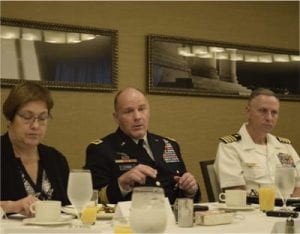
Most Sealift Vessels Measured Up in 32-Ship ‘Pressure Test,’ Army General Says by Otto Kreisher of Seapower Magazine
Most of the ships mobilized in a severe “stress test” of the Maritime Administration’s and Military Sealift Command’s ability to get their aged fleets under way in a crisis did “pretty well,” but the commander of the U.S. Transportation Command wants to accelerate the programs to modernize that crucial force.
“If it were up to me, we’d be doing it faster,” and he discussed that objective with Navy Secretary Richard V. Spencer, Army Gen. Stephen R. Lyons, commander of U.S. Transportation Command, said Oct. 2.
“We’re in the process of working with the Navy.”
In late September with little advance notice, MARAD and MSC mobilized 32 of their transport and support ships from both the forces normally on alert status and those in the Ready Reserve, which take more time and effort to get under way.
The exercise was a test of the capability of ships that are considered ancient by commercial standards and the availability of civilian mariners qualified to operate such ships, which include some of the last steam-powered vessels in the world. Independent analysts and some Navy officers have warned that the aged vessels and the declining numbers of qualified mariners could hobble the Navy’s ability to transport and sustain forces committed to an overseas conflict.
Of the 32 ships activated, “I would say most of them did pretty well. We’re waiting for final results. But in terms of sea trials, initial reporting, it was in the 80% to 85% range” of activating ships to task, Lyons told a Defense Writers breakfast. “Of those 32 ships, the average is 43 years old. In commercial industry it’s about 15.”
He added: “It was a great pressure test. We’ll look at the numbers, also get the quality assessment” in a detailed report that could be available by the end of October.
Asked if he was making any progress on the three-tiered program Congress has approved to modernize the sealift and prepositioning fleets — by upgrading the newest ships, building some new ones and buying a lot of used commercial ships — Lyons said “yes,” but he wants to accelerate the effort.
“What I’d like to do in the authorization to acquire used vessels is to accelerate that. … I know there is work now at the [Navy] Department to fund the seven,” which include two new and five used. “I’m pushing to accelerate. The Navy program now needs to be plussed up. … But the secretary and others are in favor of finding the money.”
Lyons also expressed concern with the progress on efforts to solve a far different problem that has drawn widespread criticism from Congress and service families — the perpetual failure of commercial movers hired by the services to get household goods from one home to another in a reasonable time and in good condition.
The command issued a request for proposals two weeks ago and has gotten a lot of interest from firms willing to take on what would be a nationwide contract to provide the tens of thousands of household moves every year, Lyons said. The major failure in the existing program was the inability to hold contractors accountable and to lack of a national system with common standards and the ability to inform managers in different regions of a poor performing contractor elsewhere.
“Inside the Department, we don’t have clear lines to hold them accountable for delivering the service. … And most of all, we have to have a consistent pattern of quality of delivery,” he said.
Original article can be found here.
Other articles:
DoD News: Transcom Moves Troops, Gear Quickly to Project Power
Breaking Defense: TRANSCOM Chief: No More KC-135s Now Planned
National Defense Magazine:JUST IN: Transportation Command Embracing Artificial Intelligence
Defense Daily: U.S. Transportation Command Taking Measured Approach to Integrating AI
Federal News Network: TRANSCOM says capable businesses are applying to manage military moves
Army Magazine: ARMY CONTINUES TO IMPROVE HOUSEHOLD MOVES
Inside Defense: TRANSCOM crafting follow-on capability study with a broader scope
TASS: US discusses with Central Asian countries the possibility of transit of military and other aircraft


